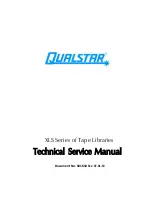
Cheetah 15K.6 SAS Product Manual, Rev. C
11
If the drive receives a START STOP UNIT command with the START bit equal to 0 before receiving a NOTIFY
(ENABLE SPINUP) primitive, the drive waits for a START STOP UNIT command with the START bit equal to 1.
After receiving a START STOP UNIT command with the START bit equal to 1, the drive waits for a NOTIFY
(ENABLE SPINUP) primitive. After receiving a NOTIFY (ENABLE SPINUP) primitive through either port, the
drive becomes ready for normal operations within 20 seconds (excluding the error recovery procedure).
If the drive receives a START STOP UNIT command with the START bit and IMMED bit equal to 1 and does
not receive a NOTIFY (ENABLE SPINUP) primitive within 5 seconds, the drive fails the START STOP UNIT
command.
The START STOP UNIT command may be used to command the drive to stop the spindle. Stop time is 30 sec-
onds (maximum) from removal of DC power. There is no power control switch on the drive.
5.4
Prefetch/multi-segmented cache control
The drive provides a prefetch (read look-ahead) and multi-segmented cache control algorithms that in many
cases can enhance system performance. Cache refers to the drive buffer storage space when it is used in
cache operations. To select this feature, the host sends the Mode Select command with the proper values in
the applicable bytes in page 08h. Prefetch and cache operations are independent features from the standpoint
that each is enabled and disabled independently using the Mode Select command; however, in actual opera-
tion, the prefetch feature overlaps cache operation somewhat as described in sections 5.5.1 and 5.5.2.
All default cache and prefetch mode parameter values (Mode Page 08h) for standard OEM versions of this
drive family are given in Section 10.3.2.1.
5.5
Cache operation
Note.
Refer to the
SAS Interface Manual
for more detail concerning the cache bits.
Of the 16 Mbytes physical buffer space in the drive, approximately 13,000 kbytes can be used as a cache. The
buffer is divided into logical segments from which data is read and to which data is written.
The drive keeps track of the logical block addresses of the data stored in each segment of the buffer. If the
cache is enabled (see RCD bit in the
SAS Interface Manual
), data requested by the host with a read command
is retrieved from the buffer, if possible, before any disk access is initiated. If cache operation is not enabled, the
buffer is still used, but only as circular buffer segments during disk medium read operations (disregarding
Prefetch operation for the moment). That is, the drive does not check in the buffer segments for the requested
read data, but goes directly to the medium to retrieve it. The retrieved data merely passes through some buffer
segment on the way to the host. All data transfers to the host are in accordance with buffer-full ratio rules. See
the explanation provided with the information about Mode Page 02h (disconnect/reconnect control) in the
SAS
Interface Manual
.
The following is a simplified description of the prefetch/cache operation:
Case A
—read command is received and all of the requested logical blocks are already in the cache:
1.
Drive transfers the requested logical blocks to the initiator.
Case B
—A Read command requests data, and at least one requested logical block is not in any segment of
the cache:
1.
The drive fetches the requested logical blocks from the disk and transfers them into a segment, and then
from there to the host in accordance with the Mode Select Disconnect/Reconnect parameters, page 02h.
2.
If the prefetch feature is enabled, refer to section 5.5.2 for operation from this point.
Each cache segment is actually a self-contained circular buffer whose length is an integer number of logical
blocks. The drive dynamically creates and removes segments based on the workload. The wrap-around capa-
bility of the individual segments greatly enhances the cache’s overall performance.
















































